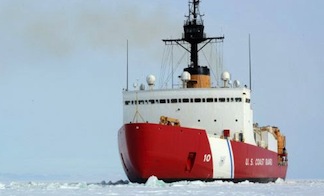The following is a blog post on the U.S. Coast Guard's Compass page:
(WASHINGTON) — If you followed the Coast Guard’s Instagram account or this blog last week, you would have been privy to the remarkable sights and sounds of our nation’s only heavy icebreaker, Polar Star, clearing a channel through a nearly 70-mile ice field, ranging from 2- to 10-feet thick, to reach the base at McMurdo. Today, as Polar Star and crew are at the far reaches of our planet for Operation Deep Freeze, senior Coast Guard leaders gathered in the nation’s capital to communicate the strategic need for icebreakers.
Coast Guard Vice Commandant Adm. Charles Michel briefed the Committee on Polar Icebreaker Cost Assessment, sharing how our nation’s security and sovereign interests hinge upon year-round, assured access to the polar regions.
The icebreaker-focused briefing served as an opportunity for the vice commandant to highlight two heavy icebreakers — the nation’s entire inventory of this strategic asset. Only one is operational, Polar Star, and Coast Guard cutter Polar Sea, the other heavy icebreaker, reached the end of its serviceable life in 2010 having suffered casualties to two main engines.
Notably, Polar Star has been in operation for more than four decades. The admiral stressed how this aging asset requires substantial upkeep to operate. Further, he reiterated how the dearth of icebreakers ultimately means the nation’s needs are not met.
“To be clear,” said the admiral, “our current fleet does not meet this need. We currently cannot guarantee year-round, assured access.”
“If Polar Star were to suffer a casualty, we have zero self-rescue capability,” added the admiral.
Due to the age and material condition of these vessels, the admiral spoke of the need for modern, capable icebreakers as a national security imperative. To that end, the admiral shared key findings from a 2010 study that identified the need for three heavy and three medium icebreakers to provide sufficient capability to support U.S. national interests in the polar regions.
The admiral also spoke of progress in recapitalizing the national fleet. Last summer, the Coast Guard established an integrated program that allows the Navy and Coast Guard shipbuilding programs to share best practices. He said he “could not be more pleased” by the work of the integrated program as they continue toward the acquisition of the United States’ first heavy polar icebreaker in more than 40 years.
He ended his remarks by sharing his optimism for continued momentum across the whole of government.
“I will close by again expressing my gratitude to this committee for your attention to this important issue and to our nation’s elected officials with whom we share a sense of urgency to recapitalize our nation’s icebreaking fleet,” said the admiral.
The committee — organized through the Transportation Research Board of the National Academy of Sciences, Engineering and Medicine — was directed by Congress to develop a report to inform future options regarding the acquisition and operation of one or more heavy icebreakers.
This is the first information-gathering session for the committee, taking place over a two-day period. The committee aims to publish its finding in a July 2017 report.
Vice Adm. Charles Ray, the Coast Guard’s deputy commandant for operations, and Rear Adm. Michael Haycock, the service’s director of acquisition programs, joined the vice commandant alongside leaders from the Navy, National Oceanic and Atmospheric Administration, National Science Foundation and Department of State.

